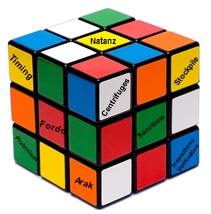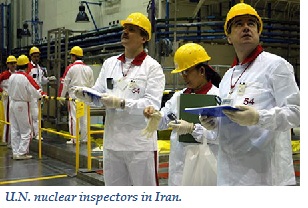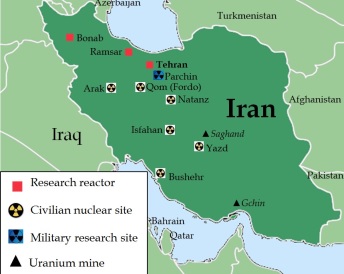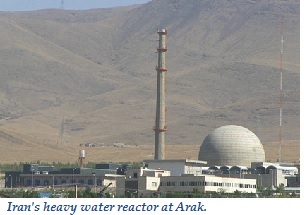 In the final weeks before the June 30 deadline for a nuclear deal, negotiators from Iran and the world's six major powers continued to work through complex issues. The United States compares negotiations to solving a Rubik’s Cube™, because so many pieces are involved—and moving one moves all the others. (The world’s most popular puzzle has 43 quintillion permutations to solve it so all the colors match on the six faces.)
In the final weeks before the June 30 deadline for a nuclear deal, negotiators from Iran and the world's six major powers continued to work through complex issues. The United States compares negotiations to solving a Rubik’s Cube™, because so many pieces are involved—and moving one moves all the others. (The world’s most popular puzzle has 43 quintillion permutations to solve it so all the colors match on the six faces.)
 It may also cover access to sites suspected of past work on bomb components, such as Parchin military base. And it is likely to require Tehran’s acceptance of the IAEA’s “Additional Protocol,” allowing inspections at both declared and undeclared sites—and maybe other intrusive measures.
It may also cover access to sites suspected of past work on bomb components, such as Parchin military base. And it is likely to require Tehran’s acceptance of the IAEA’s “Additional Protocol,” allowing inspections at both declared and undeclared sites—and maybe other intrusive measures.- The IAEA will have regular access to all of Iran’s nuclear facilities, including to Iran’s enrichment facility at Natanz and its former enrichment facility at Fordow, and including the use of the most up-to-date, modern monitoring technologies.
- Inspectors will have access to the supply chain that supports Iran’s nuclear program. The new transparency and inspections mechanisms will closely monitor materials and/or components to prevent diversion to a secret program.
- Inspectors will have access to uranium mines and continuous surveillance at uranium mills, where Iran produces yellowcake, for 25 years.
- Inspectors will have continuous surveillance of Iran’s centrifuge rotors and bellows production and storage facilities for 20 years. Iran’s centrifuge manufacturing base will be frozen and under continuous surveillance.
- All centrifuges and enrichment infrastructure removed from Fordow and Natanz will be placed under continuous monitoring by the IAEA.
- A dedicated procurement channel for Iran’s nuclear program will be established to monitor and approve, on a case by case basis, the supply, sale, or transfer to Iran of 3 certain nuclear-related and dual use materials and technology – an additional transparency measure.
- Iran has agreed to implement the Additional Protocol of the IAEA, providing the IAEA much greater access and information regarding Iran’s nuclear program, including both declared and undeclared facilities.
- Iran will be required to grant access to the IAEA to investigate suspicious sites or allegations of a covert enrichment facility, conversion facility, centrifuge production facility, or yellowcake production facility anywhere in the country.
- Iran has agreed to implement Modified Code 3.1 requiring early notification of construction of new facilities.
- Iran will implement an agreed set of measures to address the IAEA’s concerns regarding the Possible Military Dimensions (PMD) of its program.
- Iran will receive sanctions relief, if it verifiably abides by its commitments.
- U.S. and E.U. nuclear-related sanctions will be suspended after the IAEA has verified that Iran has taken all of its key nuclear-related steps. If at any time Iran fails to fulfill its commitments, these sanctions will snap back into place.
- The architecture of U.S. nuclear-related sanctions on Iran will be retained for much of the duration of the deal and allow for snap-back of sanctions in the event of significant non-performance.
- All past UN Security Council resolutions on the Iran nuclear issue will be lifted simultaneous with the completion, by Iran, of nuclear-related actions addressing all key concerns (enrichment, Fordow, Arak, PMD, and transparency).
- However, core provisions in the UN Security Council resolutions – those that deal with transfers of sensitive technologies and activities – will be re-established by a new UN Security Council resolution that will endorse the JCPOA and urge its full implementation. It will also create the procurement channel mentioned above, which will serve as a key transparency measure. Important restrictions on conventional arms and ballistic missiles, as well as provisions that allow for related cargo inspections and asset freezes, will also be incorporated by this new resolution.
- A dispute resolution process will be specified, which enables any JCPOA participant, to seek to resolve disagreements about the performance of JCPOA commitments
- If an issue of significant non-performance cannot be resolved through that process, then all previous UN sanctions could be re-imposed.
- U.S. sanctions on Iran for terrorism, human rights abuses, and ballistic missiles will remain in place under the deal.
CENTRIFUGES
Since 2002, Iran has built centrifuges to enrich uranium, which can fuel both peaceful energy and deadly bombs. Tehran claims it is only for medical research and energy. But Iran’s abilities far exceed its current needs; Russia provides fuel for Iran’s single nuclear reactor.
 Iran now has about 19,000 centrifuges—up from less than 200 a decade ago. The vast majority of these are first-generation “IR-1” centrifuges, but Iran has begun installing much more sophisticated “IR-2” models. About 10,000 are enriching uranium at Iran’s two enrichment facilities, Natanz and Fordow; the rest are installed but not operating.
Iran now has about 19,000 centrifuges—up from less than 200 a decade ago. The vast majority of these are first-generation “IR-1” centrifuges, but Iran has begun installing much more sophisticated “IR-2” models. About 10,000 are enriching uranium at Iran’s two enrichment facilities, Natanz and Fordow; the rest are installed but not operating.- Iran has agreed to reduce by approximately two-thirds its installed centrifuges. Iran will go from having about 19,000 installed today to 6,104 installed under the deal, with only 5,060 of these enriching uranium for 10 years. All 6,104 centrifuges will be IR-1s, Iran’s first-generation centrifuge.
A final deal could seek to limit enrichment to five percent or less. The White House fact sheet indicated that Iran would be required to refrain from enriching uranium over 3.67 percent for 15 years.
- Iran has agreed to not enrich uranium over 3.67 percent for at least 15 years.
- All excess centrifuges and enrichment infrastructure will be placed in IAEA monitored storage and will be used only as replacements for operating centrifuges and equipment.
- Iran has agreed to not build any new facilities for the purpose of enriching uranium for 15 years.
- Iran’s breakout timeline – the time that it would take for Iran to acquire enough fissile material for one weapon – is currently assessed to be 2 to 3 months. That timeline will be extended to at least one year, for a duration of at least ten years, under this framework.
A deal could seek to limit the stockpile of 5 percent enriched uranium and require Iran to further reduce its stockpile of 20 percent uranium in oxide form. Iran may be allowed to keep some for research, but not enough to quickly build a bomb.
- Iran has agreed to reduce its current stockpile of about 10,000 kg of low-enriched uranium (LEU) to 300 kg of 3.67 percent LEU for 15 years.
FM @JZarif: For next 15 years, we'll either turn most of stockpile into fuel or sell it on international markets
— Iran Nuclear Energy (@nuclearenergyir) April 4, 2015A deal will try to limit the program at Natanz. Zarif and Mogherini’s statement did not mention Natanz other than to clarify that it will be the only remaining enrichment facility. The White House fact sheet laid out more specific limits on enrichment and research at Natanz.
- Iran has agreed to only enrich uranium using its first generation (IR-1 models) centrifuges at Natanz for ten years, removing its more advanced centrifuges.
- Iran will remove the 1,000 IR-2M centrifuges currently installed at Natanz and place them in IAEA monitored storage for ten years.
- Iran will not use its IR-2, IR-4, IR-5, IR-6, or IR-8 models to produce enriched uranium for at least ten years. Iran will engage in limited research and development with its advanced centrifuges, according to a schedule and parameters which have been agreed to by the P5+1.
- For ten years, enrichment and enrichment research and development will be limited to ensure a breakout timeline of at least 1 year. Beyond 10 years, Iran will abide by its enrichment and enrichment R&D plan submitted to the IAEA, and pursuant to the JCPOA, under the Additional Protocol resulting in certain limitations on enrichment capacity.
 The smaller, underground enrichment facility near Qom includes two halls; each could hold 1,500 centrifuges. Iran claims Fordow is to enrich uranium up to 20 percent— only for research. But skeptics contend the deeply-buried site, designed to survive aerial bombardment, is intended to take 20 percent enriched material from Natanz and enrich it to higher levels for use in a nuclear weapon.
The smaller, underground enrichment facility near Qom includes two halls; each could hold 1,500 centrifuges. Iran claims Fordow is to enrich uranium up to 20 percent— only for research. But skeptics contend the deeply-buried site, designed to survive aerial bombardment, is intended to take 20 percent enriched material from Natanz and enrich it to higher levels for use in a nuclear weapon.A deal will try to end enrichment activities at Fordow. Both the Zarif and Mogherini statement and the White House fact sheet suggested it will be converted to a research-only facility.
- Iran has agreed to not enrich uranium at its Fordow facility for at least 15 years.
- Iran has agreed to convert its Fordow facility so that it is used for peaceful purposes only – into a nuclear, physics, technology, research center.
- Iran has agreed to not conduct research and development associated with uranium enrichment at Fordow for 15 years.
- Iran will not have any fissile material at Fordow for 15 years.
- Almost two-thirds of Fordow’s centrifuges and infrastructure will be removed. The remaining centrifuges will not enrich uranium. All centrifuges and related infrastructure will be placed under IAEA monitoring.
 The small heavy-water reactor, begun in the 1990s, is unfinished. Iran claims it is to produce medical isotopes and thermal power for civilian use. But the design would also produce plutonium that, if chemically reprocessed, could provide an alternative fuel to uranium for an atomic bomb. Nine kilograms of plutonium is enough material to fuel one or two nuclear weapons. After completion, Arak would need to run for 12 to 18 months to generate that much plutonium.
The small heavy-water reactor, begun in the 1990s, is unfinished. Iran claims it is to produce medical isotopes and thermal power for civilian use. But the design would also produce plutonium that, if chemically reprocessed, could provide an alternative fuel to uranium for an atomic bomb. Nine kilograms of plutonium is enough material to fuel one or two nuclear weapons. After completion, Arak would need to run for 12 to 18 months to generate that much plutonium.A deal will try to close Arak or redesign it in a way to substantially reduce plutonium output. A deal will also try prohibit Iran from building a reprocessing facility. On April 2, negotiators agreed to redesign the facility so that it is no longer capable of producing weapons grade plutonium.
- Iran has agreed to redesign and rebuild a heavy water research reactor in Arak, based on a design that is agreed to by the P5+1, which will not produce weapons grade plutonium, and which will support peaceful nuclear research and radioisotope production.
- The original core of the reactor, which would have enabled the production of significant quantities of weapons-grade plutonium, will be destroyed or removed from the country.
- Iran will ship all of its spent fuel from the reactor out of the country for the reactor’s lifetime.
- Iran has committed indefinitely to not conduct reprocessing or reprocessing research and development on spent nuclear fuel.
- Iran will not accumulate heavy water in excess of the needs of the modified Arak reactor, and will sell any remaining heavy water on the international market for 15 years.
- Iran will not build any additional heavy water reactors for 15 years.
